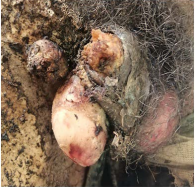INTRODUCTION
Electrocution accidents are defined by the passage of an electric current through the body. It usually takes place at home or in a professional setting. The analysis of the lesions at different affected systems (such as, cardiovascular, respiratory, cutaneous, neurological, and renal systems) which has affected in this case has allowed us to discover an unusual exit point.
OBSERVATION
A 36-year-old patient was presented with no notable pathological history who was victim of an electrocution accident by a high voltage electric current during the exercise of his profession as a house-painter. The initial examination in the intensive care unit found an unconscious patient, with a blood pressure at 100/50 mmHg, a tachycardia and a full bladder. The skin lesions were in the form of 2nd and 3rd-degree burns, occupying approximately 28% of the body surface and involving the internal sides of the thighs and the upper limbs. The urogenital examination found exposed scrotal tunics with necrosis of the penis and a retraction of the urethra (Figure 1). The treatment provided to the patient was based on resuscitation measures in order to maintain and support his vital functions. A suprapubic catheter was put to drain the urine. Afterward, he was admitted to the operating room for fasciotomy, treatment of burns and repair surgery of the genital organs. Unfortunately, he died from a cardiogenic shock.
Figure 1. Photo of the Genitals Showing Exposed Scrotal Tunics (Red arrow) with Necrosis of the Penis (Green arrow) and a Retraction of the Urethra (Yellow arrow)

DISCUSSION
The energy produced by the high voltage current is often so high that it causes severe burns. Most often, injuries sit in the point of contact or in the current’s exit. A patient can have multiple entry and exit points. The most affected body parts are hands and head. As for the exit area, it is most often the heels.1,2 Indeed, the genitals are an unusual exit point.3,4 As in the case of traumatic or surgical amputation, penis reconstruction can be indicated in the case of penis necrosis secondary to an electrocution.3 The reconstructive surgery aims to have an adequate length phallus with an apical meatus allowing satisfactory urinary and sexual functions.5 Among the several techniques described, the penile lengthening by partial mobilization of the residual corpora cavernosa and spongiosa with covering by scrotal skin seems to allow the best results on the sensory and aesthetic level.3,5,6
CONCLUSION
High voltage electric current can cause serious injury, including death. Among these injuries, necrosis of the penis as found in this case is extremely rare. The treatment consists on a phalloplasty with urethroplasty to insure urinary and sexual functions.
CONSENT
The authors have received written informed consent from the patient.
CONFLICTS OF INTEREST
The authors declare that they have no conflicts of interest.






